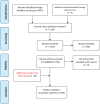Application of Machine Learning in Diagnosis of COVID-19 Through X-Ray and CT Images: A Scoping Review
- PMID: 33842563
- PMCID: PMC8027078
- DOI: 10.3389/fcvm.2021.638011
Application of Machine Learning in Diagnosis of COVID-19 Through X-Ray and CT Images: A Scoping Review
Abstract
Coronavirus disease, first detected in late 2019 (COVID-19), has spread fast throughout the world, leading to high mortality. This condition can be diagnosed using RT-PCR technique on nasopharyngeal and throat swabs with sensitivity values ranging from 30 to 70%. However, chest CT scans and X-ray images have been reported to have sensitivity values of 98 and 69%, respectively. The application of machine learning methods on CT and X-ray images has facilitated the accurate diagnosis of COVID-19. In this study, we reviewed studies which used machine and deep learning methods on chest X-ray images and CT scans for COVID-19 diagnosis and compared their performance. The accuracy of these methods ranged from 76% to more than 99%, indicating the applicability of machine and deep learning methods in the clinical diagnosis of COVID-19.
Keywords: COVID-19; X-ray image; biomarker; detection; machine learning.
Copyright © 2021 Mohammad-Rahimi, Nadimi, Ghalyanchi-Langeroudi, Taheri and Ghafouri-Fard.
Conflict of interest statement
The authors declare that the research was conducted in the absence of any commercial or financial relationships that could be construed as a potential conflict of interest.
Figures
References
-
- Ghafouri-Fard S, Noroozi R, Omrani MD, Branicki W, Pośpiech E, Sayad A, et al. Angiotensin converting enzyme: a review on expression profile and its association with human disorders with special focus on SARS-CoV-2 infection. Vascular Pharmacol. (2020) 130:106680. 10.1016/j.vph.2020.106680 - DOI - PMC - PubMed
Publication types
LinkOut - more resources
Full Text Sources
Other Literature Sources


